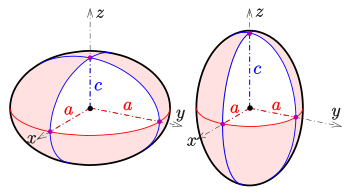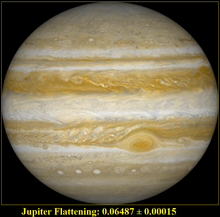Spheroid

| ||
| oblate | prolate | |
|---|---|---|
A spheroid, also known as an ellipsoid of revolution or rotational ellipsoid, is a
If the ellipse is rotated about its
Due to the combined effects of
The word spheroid originally meant "an approximately spherical body", admitting irregularities even beyond the bi- or tri-axial ellipsoidal shape; that is how the term is used in some older papers on geodesy (for example, referring to truncated spherical harmonic expansions of the
Equation

The equation of a tri-axial ellipsoid centred at the origin with semi-axes a, b and c aligned along the coordinate axes is
The equation of a spheroid with z as the
The semi-axis a is the equatorial radius of the spheroid, and c is the distance from centre to pole along the symmetry axis. There are two possible cases:
- c < a: oblate spheroid
- c > a: prolate spheroid
The case of a = c reduces to a sphere.
Properties
Area
An oblate spheroid with c < a has surface area
The oblate spheroid is generated by rotation about the z-axis of an ellipse with semi-major axis a and semi-minor axis c, therefore e may be identified as the eccentricity. (See ellipse.)[2]
A prolate spheroid with c > a has surface area
The prolate spheroid is generated by rotation about the z-axis of an ellipse with semi-major axis c and semi-minor axis a; therefore, e may again be identified as the eccentricity. (See ellipse.) [3]
These formulas are identical in the sense that the formula for Soblate can be used to calculate the surface area of a prolate spheroid and vice versa. However, e then becomes imaginary and can no longer directly be identified with the eccentricity. Both of these results may be cast into many other forms using standard mathematical identities and relations between parameters of the ellipse.
Volume
The volume inside a spheroid (of any kind) is
If A = 2a is the equatorial diameter, and C = 2c is the polar diameter, the volume is
Curvature
Let a spheroid be parameterized as
where β is the reduced latitude or
and its mean curvature is
Both of these curvatures are always positive, so that every point on a spheroid is elliptic.
Aspect ratio
The aspect ratio of an oblate spheroid/ellipse, c : a, is the ratio of the polar to equatorial lengths, while the flattening (also called oblateness) f, is the ratio of the equatorial-polar length difference to the equatorial length:
The first eccentricity (usually simply eccentricity, as above) is often used instead of flattening.[4] It is defined by:
The relations between eccentricity and flattening are:
All modern geodetic ellipsoids are defined by the semi-major axis plus either the semi-minor axis (giving the aspect ratio), the flattening, or the first eccentricity. While these definitions are mathematically interchangeable, real-world calculations must lose some precision. To avoid confusion, an ellipsoidal definition considers its own values to be exact in the form it gives.
Applications
The most common shapes for the density distribution of protons and neutrons in an
.Oblate spheroids

The oblate spheroid is the approximate shape of rotating
Prolate spheroids

The prolate spheroid is the approximate shape of the ball in several sports, such as in the rugby ball.
Several
.In contrast to being distorted into oblate spheroids via rapid rotation, celestial objects distort slightly into prolate spheroids via tidal forces when they orbit a massive body in a close orbit. The most extreme example is Jupiter's moon Io, which becomes slightly more or less prolate in its orbit due to a slight eccentricity, causing intense volcanism. The major axis of the prolate spheroid does not run through the satellite's poles in this case, but through the two points on its equator directly facing toward and away from the primary. This combines with the smaller oblate distortion from the synchronous rotation to cause the body to become triaxial.
The term is also used to describe the shape of some nebulae such as the Crab Nebula.[7] Fresnel zones, used to analyze wave propagation and interference in space, are a series of concentric prolate spheroids with principal axes aligned along the direct line-of-sight between a transmitter and a receiver.
The atomic nuclei of the actinide and lanthanide elements are shaped like prolate spheroids.[8] In anatomy, near-spheroid organs such as testis may be measured by their long and short axes.[9]
Many submarines have a shape which can be described as prolate spheroid.[10]
Dynamical properties
For a spheroid having uniform density, the
where M is the mass of the body defined as
See also
- Ellipsoidal dome
- Equatorial bulge
- Great ellipse
- Lentoid
- Oblate spheroidal coordinates
- Ovoid
- Prolate spheroidal coordinates
- Rotation of axes
- Translation of axes
References
- ISBN 9783110170726.
- ^ A derivation of this result may be found at "Oblate Spheroid - from Wolfram MathWorld". Mathworld.wolfram.com. Retrieved 24 June 2014.
- ^ A derivation of this result may be found at "Prolate Spheroid - from Wolfram MathWorld". Mathworld.wolfram.com. 7 October 2003. Retrieved 24 June 2014.
- ^ Brial P., Shaalan C.(2009), Introduction à la Géodésie et au geopositionnement par satellites, p.8
- S2CID 121268606.
- ISBN 1567310192.
- doi:10.1086/129507
- ^ "Nuclear fission - Fission theory". Encyclopedia Britannica.
- ISBN 9781455737666.
- ^ "What Do a Submarine, a Rocket and a Football Have in Common?". Scientific American. 8 November 2010. Retrieved 13 June 2015.
- ^ Weisstein, Eric W. "Spheroid". MathWorld--A Wolfram Web Resource. Retrieved 16 May 2018.
External links
 Media related to Spheroids at Wikimedia Commons
Media related to Spheroids at Wikimedia Commons- . Encyclopædia Britannica (11th ed.). 1911.














